Exam Details
Exam Code
:QSDA2022Exam Name
:Qlik Sense Data Architect Certification - 2022Certification
:QlikView CertificationsVendor
:QlikViewTotal Questions
:77 Q&AsLast Updated
:Jun 06, 2025
QlikView QlikView Certifications QSDA2022 Questions & Answers
-
Question 11:
Refer to the exhibit.
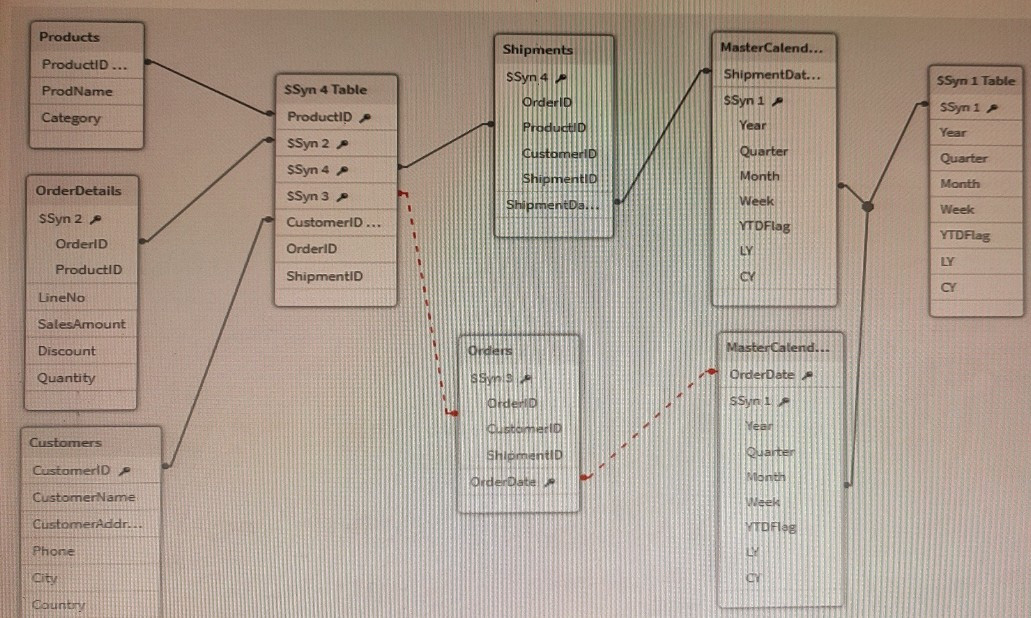
A data architect is working on a Qlik Sense app the business has created to analyze the company orders and shipments. To understand the table structure, the business has given the following summary:
Every order creates a unique orderlD and an order date in the Orders table An order can contain one or more order lines one for each product ID in the order details table Products in the order are shipped (shipment date) as soon as tliey are ready and can be shipped separately The dates need to be analyzed separately by Year Month, and Quarter
The data architect realizes the data model has issues that must be fixed.
Which steps should the data architect perform?
A. 1. Create a key with OrderlD and ProductID in the OrderDetails table and in the Orders table
2.
Delete the ShipmentID in the Shipments table
3.
Delete the ProductID and OrderlD in the OrderDetails table
4.
Concatenate Orders and OrderDetails
5.
Create a link table using the MasterCalendar table and create a concatenated field between OrderDate and ShipmentDate
B. 1. Create a key with OrderlD and ProductID in the OrderDeta Is table and in the Shipments table
2.
Delete the ShipmentID in the Orders table
3.
Delete the ProductID and OrderlD in the Shipmi
4.
Left join Orders and OrderDetails
5.
Use Derive statement with the MasterCalendar table and apply the derive fields to OrderDate and ShipmentDate
C. 1. Create a key with OrderlD and ProductID in the OrderDetails tab e and in the Orders table
2.
Delete the ShipmentID in the Shipments table
3.
Delete the ProductID and OrderlD in the OrderDetails
4.
Left join Orders and OrderDetails
5.
Use Derive statement with the MasterCalendar table and apply the derive fields to OrderDate and ShipmentDate
D. 1. Create a key with OrderlD and ProductID in the OrderDetails table and in the Shipments table
2. Delete the ShipmentID in the Orders table
3 Delete the ProductID and OrderlD in the Shipments table
4. Concatenate Orders and OrderDetails
-
Question 12:
A data architect needs to create an app that combines employee data from the Sales system and the Human Resources (HR) system.
These systems identify employees differently Employees in the HR system are identified with an alpha-numeric key Employees in the Sales system are identified using an integer key.
The Human Resources manager creates a table that maps these keys to another, called Associations.
The resultant data model must meet the following requirements:
Associations must be valid The model must be optimized for performance The option must support multiple tables added
Which solution should the data architect use to meet these requirements?
A. APPLYMAP ( 'Associations , EmployeeKey ) as Employeekey;
B. MAPSUBSTRING ( 'Associations' ,EMployeekey) As Employeekey;
C. MAP EmloyeeKey USING Associations;
D. RENAME FIELDS USING Associations;
-
Question 13:
A company generates 1 GB of ticketing data daily. The data is stored in multiple tables Business users need to see trends of tickets processed for the past. 2 years Users very rarely access the transaction-level data for a specific date. Only the past 2 years of data must be loaded which is 720 GB of data
Which method should a data architect use to meet these requirements?
A. Load only aggregated data for 2 years and use On-Demand App Generation (ODAG) for transaction data
B. Load only aggregated data for 2 years and apply filters on a sheet for transaction data
C. Load only 2 years of data in an aggregated app and create a separate transaction app for occasional use
D. Load only 2 years of data and use best practices in scripting and visualization to calculate and display aggregated data
-
Question 14:
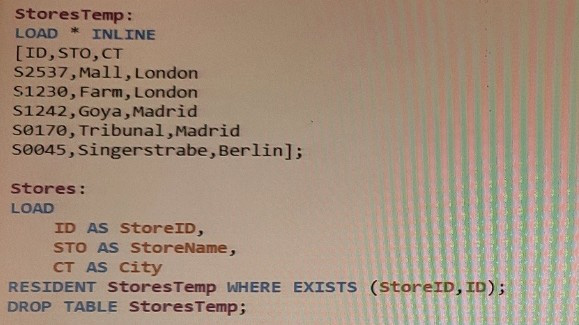
Refer to the exhibit
A data architect develops an app for Coffee4all, a coffee company with stores located throughout Europe
The script runs successfully, but the Stores table does not have any values.
What should the data architect do?
A. Use where exists (ID, StorelD)
B. Use where exists (ID)
C. Use Concatenate before loading the Stores table
-
Question 15:
A data architect needs to create an app to analyze 30-day re-admissions at a hospital.
The medical record system does NOT calculate re-admission data The business rule to follow: if a patient is admitted to a hospital within 30 days after being discharged from a previous hospital stay, that event should be captured in the app with a flag called "30-day Re-admission" Data being used from the patient record includes hospital account ID, patient ID, admission dater and discharge date
Which action should the data architect perform first to meet these requirements?
A. Sequence patient records by hospital account ID and patient ID using the Peek function
B. Sequence patient records by patient ID using the Peek function
C. Calculate the days since previous discharge using admission date and discharge date
D. Order patient records by patient ID and admission date
-
Question 16:
Refer to the exhibit.

An existing app on Qlik Sense Enterprise is duplicated and transferred to a data architect to add some additional data When trying to manually reload the original script, the data architect receives an error What should be done to make sure the script runs correctly?
A. Add the line lib connect to 'QVD(abc_qservice/orderData.qvd) '; before the LOAD for the Order Data table
B. Add the line lib connect to ' SQL (abc_qs9rvi.es) ` ;before the LOAD for the Order Detail table
C. Give the data architect the Read rights on the data connections in the QMC
D. Make the data architect the owner of the app in the QMC
-
Question 17:
Refer to the exhibit.

What are the values of the variables vLoadStart and vLoadComplete after the script executes?
A. vLoadStart; 'NOW{)' vLoadComplete: current system date and time when the script ended
B. vLoadStart: system date when the app was opened vLoadComplete 'now()'
C. vLoadStart: system date when the app was opened vLoadComplete: current system date and time when the script ended
D. vLoadStart: current system date and time when the script started vLoadComplete: 'now()'
-
Question 18:
Refer to the exhibit.
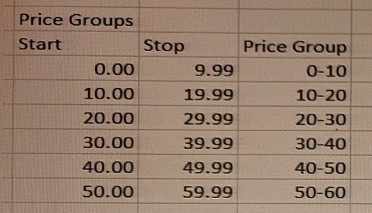
A data architect must classify each product into a price group. The price groups must be the same width by default and allow users to dynamically change the width of the bucket during analysis. Which feature should the data architect use to meet these requirements?
A. Class function in the script and use variables
B. Class function in a calculated dimension
C. Nested IFs in a calculated dimension
D. IntervalMatch and use variables
-
Question 19:
Refer to the exhibit.

The data architect needs to create a KPI that displays the average amount of orders per customer. This aggregated field should be added to the existing orders table Which script should the data architect use?
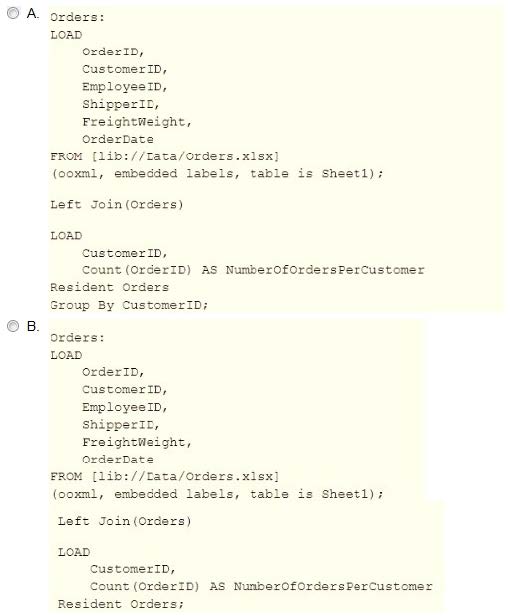
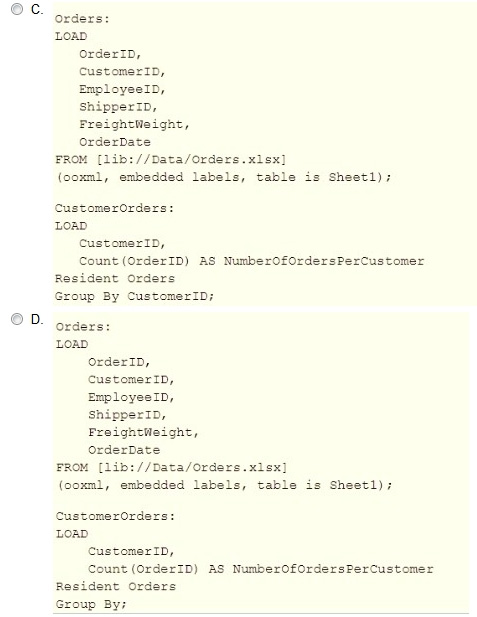
A. Option A
B. Option B
C. Option C
D. Option D
-
Question 20:
Refer to the exhibit.

A data architect executes the script.
What will be the value of the first row for Field_1?
A. A
B. D
C. Null
D. 4
Related Exams:
QREP
Qlik Replicate CertificationQSBA2021
Qlik Sense Business Analyst Certification - February 2021 ReleaseQSBA2024
Qlik Sense Business Analyst Certification - 2024QSDA2018
Qlik Sense Data Architect Certification - June 2018 ReleaseQSDA2019
Qlik Sense Data Architect Certification - June 2019 ReleaseQSDA2021
Qlik Sense Data Architect Certification - February 2021 ReleaseQSDA2022
Qlik Sense Data Architect Certification - 2022QSDA2024
Qlik Sense Data Architect Certification - 2024QSSA2018
Qlik Sense System Administrator Certification - June 2018 ReleaseQV_DEVELOPER_01
QlikView 11 Developer Certification
Tips on How to Prepare for the Exams
Nowadays, the certification exams become more and more important and required by more and more enterprises when applying for a job. But how to prepare for the exam effectively? How to prepare for the exam in a short time with less efforts? How to get a ideal result and how to find the most reliable resources? Here on Vcedump.com, you will find all the answers. Vcedump.com provide not only QlikView exam questions, answers and explanations but also complete assistance on your exam preparation and certification application. If you are confused on your QSDA2022 exam preparations and QlikView certification application, do not hesitate to visit our Vcedump.com to find your solutions here.